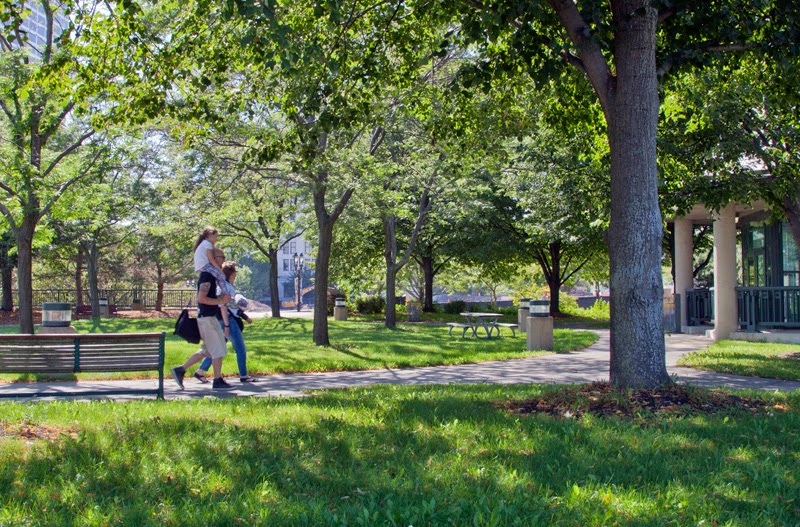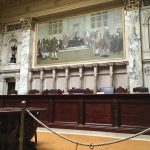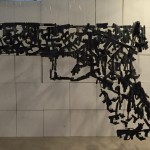Don’t Sell O’Donnell Park
The proposed plan is being sold as a chance to simply get bids from buyers, but it's really about selling our heritage to private developers.
Milwaukee County Supervisor Steve Taylor tried to assure his colleagues, and citizens, that the latest retooled scheme to offer O’Donnell Park for sale would not mean the county would actually sell the park. He claimed that he and two co-sponsors just want to see “what’s out there,” to see how much cash developers might cough up for the downtown park with the best views in town.
In other words, he and three other supervisors on the Parks, Energy and Environment Committee want developers to throw offers at the wall to see if they stick. I believe this approach is not fair to either potential bidders or the public—as owners of the park. But I assume that any developer or corporation champing at the bit to own this prime property can look out for their own interests. If they want to engage in a midwestern version of Wild West speculation, that’s their business.
Some will surely gamble on controlling and redeveloping this incomparable site and amenities that taxpayers built in 1993 for $36 million. In 2012 County Executive Chris Abele called the adjacent 2.2-acre Transit Center lot “one of the most sought-after pieces of land in the entire state.” Nonetheless, although that parcel was appraised for $9 million, Abele struck a deal to sell it to developer Rick Barrett for just $500,000. The board approved the plan. County officials have acknowledged that the incredibly low price, if the deal closes, will essentially cover their expected legal fees to make way for a sale. Given that precedent, we can’t expect county negotiators to drive a hard bargain for O’Donnell Park, even though it is also one the state’s most valuable parcels, with a promenade to Milwaukee’s iconic Calatrava addition to the Milwaukee Art Museum.
There’s another critical uncertainty that any developer must consider. Can a sale of O’Donnell Park ever be legally completed? Environmental attorneys have long asserted that, like the Transit Center, O’Donnell Park is largely built on filled lake-bed land. That means that, by Wisconsin constitutional law, the park can only be publicly owned and used for the public’s benefit. The county is now engaged in a lawsuit with Preserve Our Parks to determine the status of the Transit Center with respect to the public trust doctrine. If officials wanted to offer certainty to potential buyers, they could wait until that suit is resolved. Nonetheless, they seem cavalier about possibly placing O’Donnell—and potential buyers– in a prolonged state of legal limbo.
As with previous O’Donnell sale proposals, the park would immediately be declared “surplus property” — like a worn-out truck — and removed from Parks Department management and essentially put on the auction block. But there’s a potential escape hatch that crafters of this resolution are touting: The park (half of it dating back to 1868) could eventually be freed from banishment if the fishing expedition produces no big offers. The county board has been reassured that it could then end O’Donnell’s “surplus property” exile and rechristen it a public park. (Supervisors would do well to verify the exact procedure for that unprecedented procedure.)
As is often noted, O’Donnell Park returns at least $1.5 million annually to the parks budget. O’Donnell stands to continue this level of productivity for many more decades. Several city-owned parking structures are models of lucrative longevity (Michigan & Van Buren: age 59; Plankinton & Wells, age 55). Even the model for O’Donnell is a golden oldie. The first American park built atop a parking structure—Union Square in San Francisco—is still going strong at age 74.
Staunch park-sale promoters include supervisors Deanna Alexander and Anthony Staskunas as well as Taylor. The trio co-sponsored the current resolution. Martin Weddle also voted in favor of the proposal. Gerry Broderick, Jason Haas and Khalif Rainey voted against it in committee. Pat Jursik also strongly opposes selling O’Donnell Park. The views of other supervisors have not been declared.
The issue comes before the board this Thursday, March 26th. Please ask board members to reject this latest plot to end O’Donnell Park’s preserved status as a public park. Tell them to maintain it as a lake-view park complex, accessible to all forever, as American parks are all designated. O’Donnell Park contributes to Milwaukee’s economic vitality, quality of life and civic character. If visionary civic leaders want to re-imagine this park someday to meet ever-changing urban dynamics, that can only happen if its current sworn stewards keep O’Donnell Park publicly owned.
John Lunz is president of Preserve Our Parks.
Political Contributions Tracker
Displaying political contributions between people mentioned in this story. Learn more.
- February 1, 2016 - Khalif Rainey received $801 from Rick Barrett
Op-Ed
-
Unlocking Milwaukee’s Potential Through Smart Zoning Reform
 Jul 5th, 2024 by Ariam Kesete
Jul 5th, 2024 by Ariam Kesete
-
We Energies’ Natural Gas Plans Are A Mistake
 Jun 28th, 2024 by John Imes
Jun 28th, 2024 by John Imes
-
Milwaukee Needs New Kind of School Board
 Jun 26th, 2024 by Jordan Morales
Jun 26th, 2024 by Jordan Morales





















Having been in the development arena for over 20 years what the County apparently doesn’t understand is that it takes a considerable amount of time, effort and money to respond to an RFP and after reading this article and witnessing the cluster-**** that occured with Northwestern Mutual it is unlikely any development firm is going to take this RFP seriously.
What’s even worse…the County’s reputation has been seriously compromised by the incompetence of the majority of the County Board and it is also unlikely that outside, national firms that aren’t able to enter the Primary development markets of Chicago or Minneapolis will take their investment dollars elsewhere.
I would suggest Mr. Abele and his Board get their proverbial *hit together, focus on their part of the Arena responsibility, have a come-to-Jesus conversation with the City on their part and focus on finalizing an agreement with the THREE BILLIONAIRES that are ALREADY vested in Milwaukee before wasting a lot of other people’s time and money.
I’ve been to O’D Park several times and I don’t remember a scene like in that photo. I am right now looking at google earth and I don’t see trees like that anywhere on it. I call BS.
This is a parking garage with grass on top. Before that it was a scrubby bluff. Turn it over to the Art Museum. They know how to do it right.
Then tell POP to stick a fork in it.
One of the worst parks in the city. The incompetence of the county board is unacceptable. I can’t wait until April 2016 when these hacks get taken down a notch to part time pay. It’s time to clean house.
mbradleyc: The photo is of the upper-level North Garden Plaza, accessed by stairs from main Wisconsin Avenue plaza, or from Prospect & Mason. At this time of year the trees are bare. Seasonally, it’s a green oasis with great views of lakefront and city, benches, picnic tables, a gazebo.
Scott: If the Billionaire Boys really want to invest in MKE, they can easily afford to build their own arena (see Bruce M.’s recent story) and use it to make more millions for themselves and offer more luxury boxes for corporate entertaining. No different than any free-market biz.
I’d rather have tax money go to museums and parks (and, with parks defunding, the budget is less than 30 years ago). Prices to arena events keep average people from attending most events. The museum at least offers monthly free days, free concerts in the atrium and other programs for the community. And most park facilities, at O’Donnell etc, offer completely free public access. A good return on tax dollars for the whole public, not just elites.
MAM now wants to explore options for leasing O’Donnell, rather than having this public park transferred to a developer in a sweetheart deal. Any private owner could then block views and public access to a first-class museum and MKE’s most identifiable architecture. But some people prefer sports, so maybe taxpayers will end up paying forever for a new NBA sports palace, on top of the endless tax for Miller Park. And the county may just sell off parks one by one…
“As is often noted, O’Donnell Park returns at least $1.5 million annually to the parks budget.”
No it DOES NOT. That $1.5 million is offset by about $900,000 in debt service on prior capital projects and $300,000 in operating costs. The park itself barely pays for itself in the short term; in the long term it loses a significant amount of money because of depreciation.
The 2015 Adopted Budget already assumes O’Donnell is gone, therefore there is almost no impact on Parks if the structure were sold. In fact it would save the County – and therefore Parks – if it were sold because the debt service costs, which are budgeted in 2015, would roll off.
mbradleyc
That is an actual picture of O’Donnell Park; looking through the park toward the enclosed stairs at the north end on the right, and the intersection of E. Mason and N. Astor on the left with the Cudahy Tower barely visible.
That lone picnic table in the photo was in that same spot this past season and makes a great place for a lunch or to get some work done. I’ve done some testing and find that both my iPad and Netbook function equally well in O’Donnell Park although there was a little glare in the iPad screen; a newspaper page may ruffle slightly in the wind (I had no problem with the _Shepherd Ex._ or _Riverwest Currents_); it may be necessary to wear sunglasses while reading a book there, but there is lightly shaded seating; I was able to dispose of my picnic and dinner trash both safely and efficiently; I don’t use a cell phone, so I can’t answer for signal strength there.
The park was designed with some features that have never, or rarely, been used like a stage setting with covered wings. It would be an excellent place to enjoy a summer theater performance, or acoustic music performance as well – something that is done at the north end of Lake Park after recent construction of a stage there. I bet a modest sound system would work well.
Food, or more importantly, BEER vendors, would have no difficulty setting up their stations on the Plaza one level down. Patron stations for recycling beer could also be accommodated on the Plaza, or even on one parking level below the Park.
That’s right, I forgot about the underground parking too; I’ve never used it so I can’t answer for it. No stumbling across intersections heading back to the car after a performance, or having to leave bottles in neighborhood gutters after a walk to the car. All of O’Donnell Park stairs are equipped with railings and I’ve trudged my heavy bike up the stairs from street level below.
The O’Donnell Park Plaza? It has a mixture of both hardscape and grass seating with it’s own stage setting if the restaurant terrace was used (again, space for the obligatory beer stations easily accommodated).
While it’s still not considered sophisticated to talk about “staycations”, Milwaukeeans who spend several hours a month (all seasons) in their Milwaukee Parks wouldn’t find it so necessary to hi-tail it out of town for R&R. It’s a lot easier on the bank account too. Sunny Sunday or Saturday mornings in Milwaukee’s O’Donnell Park with coffee, bakery goods, and reading material is pure heaven.
Gary Rebholz
Apartment dweller and park user on Milwaukee’s Lower East Side since 1979 (on & off).
Over 125 years ago, some progressive thinkers got together and started a system and idea of parks and green space before all land was gobbled and locked up by private interests. It was recognized by some enlightened people with foresight that open spaces were needed for the sanity and well being of many of our fellow humans that lived in cramped crowded living conditions. In some cases these recreation sites and parks had become dumping grounds for the urban center’s litter. For example portions of Mitchell, Barren, Lincoln, Summerfest grounds, the Menomonee Valley and Lakefront areas, etc. all have dump site history. Almost all environmental and green space compromises have been made across our country. We are left with a a few crumbs for commons and green space activities for humans and some urban wildlife to thrive and enjoy. These few remaining crumbs are priceless. Once removed from public domain and space, they are likely gone and locked up forever in our human terms.
The commons and public spaces are priceless to many of us that enjoy them as part of our urban fabric.
Unfortunately FREE, doesn’t collect any tax dollars to support the existing parks.
Realistically when you put the fees for the Museum, general admission and exhibit admission, you’re looking at the cost of a Bucks/ Admirals game at the Bradley Center. Also there are plenty of other MILLION and BILLION dollar companies that can get a TIF district without a blink of the eye, but buying your way into their doors isn’t even and option. The fact that the Arena is an entertainment facility shouldn’t change the perception that it is a business like any other. These old recycled arguments are past their prime, time to step up with something new.
Finally, lets talk about improving the view of our outstanding Art Museum. That giant orange steel skeleton at the end of Wisconsin Avenue is a good place to start. Soon it will look like a chunk fell off of the NML building site and they decided to leave it there and paint it orange.
I understand the importance of parks. O’Donnell is not a desirable park south of Mason Street. Existing structures are not parks, the south end of O’Donnell park is a parking structure, not a park. The transit building is an old bus barn, not a park.
Gary R, you say there’s no reason to stumble across intersections to get to your car??? Do you think drunk driving is OK if you’re parked in a structure?
Paul,
Gary R simply edited his for brevity before posting. The original version is here:
“No passengers stumbling across intersections when headed back to the designated driver’s car after a performance.”
Last time the photo run with this Op-Ed was used on this site (New Plan to Sell O’Donnell Park Is A Mistake, February 3, 2015), the photo credit was Eddee Daniel. Now it’s Eric Oxendorf. Who will get the credit when it’s used a third time?
Mr. Lunz, to say you are being disingenuous would be putting it lightly. Nowhere does your article cite the additional repair costs necessary to sustain O’Donnell in it’s current form. I have seen some pretty large numbers that the taxpayer is going to have to cover.
Regarding the Transit center, the low sale cost of the site wasn’t just to cover the legal fees, but also make the project feasible as the developer would have to include public transit at the site or the County would have to repay the Federal subsidies which were used to build it in the first place.
POP does amazing service to the community, I doubt many people would say that it doesn’t. As someone who votes liberal primarily for environmental reasons, I can’t thank advocacy groups like you enough… But the recent pushes against the parking structure and Transit site are quickly burning whatever public support and political capital you have. These two sites have the potential to add millions of dollars in additional taxes for the City and County, and bring jobs and people downtown. Your lawsuit may end up clouding the piece of land being freed up with the 794 reconfiguration that Johnson Controls is reportedly interested in as well.
It would be an absolute travesty to have JCI walk over your fight over a glorified bus stop and a parking structure. They are in no way looking to impose on any of the major parks and public spaces along the lake. If anything, with the mini-parks replacing vacant lots, the Rotary Arboretum, the Park adjacent to the new Associated Bank branch on McKinley, and extensions of the River Walk, one might argue that Milwaukee is adding to its public spaces faster than ever, not subtracting.
Do you truly feel that the transit center and O’Donnell will ultimately lead to developers trying to push into Memorial Park or Pere Marquette? Those are assets to the community. Developers need green space like what we have to make their projects attractive. The City and County need these assets as well. Where do we draw the line on filled lake bed or even former wetlands? Should we roll it back even further?
Enough is enough. As someone who probably votes similarly to you, I beg you to back off, as Milwaukee needs as much economic development as it can get, and the sites in question are horrible eyesores and drains on our tax dollars.
Well stated John.
John G,
Getting land for almost nothing always makes a project more feasible! I don’t believe the Couture will have to cover the costs of the streetcar spur. I’ve read a TIF district will.
There can be good reasons to give developers a break, but $8.5 million off a $9 appraisal is mighty steep. I hear good things about this developer. It’s more that county administrators, acting desperate, or perhaps like cronies, keep trying to give away the store. This is not a property no one wanted.
Thanks Gary, for sharing perspectives as a visitor to O’Donnell Park. Many people go there for random visits, as with most parks that are primarily not neighborhood parks. I’m glad MAM knows its value to them and the public and wants to ensure its longevity as a public park–with the absolute BEST VIEWS OF THE LAKEFRONT and downtown. No one who actually goes to O’Donnell Park can argue with that! (Also a great place to see sensational moon rises!)
@Thomas Thanks, apparently I never updated a previous correction in the database. It has been updated to reflect the photo is by Eddee Daniel.
They could have sold it for $9MM to recoup the costs and not added in any public space and ended up with the same dollars. The $8.9MM appraisal you mentioned likely did not include the County’s requirement to repay the Federal transit dollars.
http://www.jsonline.com/blogs/business/285523611.html
Regarding O’Donnell, my understanding is that the northern portion has a deed restriction which means it is required to be reserved for the public trust. The building envelope currently occupied by Coast and the Children’s Museum could be much better utilized, and still include the Children’s museum. Why not have the best of both world’s by preserving the park, and improving our tax base?
John G.: From the JS article you linked on Couture funding:
“Mayor Barrett is proposing $17.5 million in city funds to pay for that concourse and other public improvements at the Couture, including a park on top of its parking structure, a street-level outdoor plaza and public walkways.”
So the developer gets the land for pocket change, and the city will chip in $17.5 million for “public amenities” at the project. All total, this makes the project incredibly “feasible.” Won’t other developers demand similar breaks?
People get upset about POP defending the public trust doctrine as it relates to filled lakebed. What’s the alternative? Pretend the PTD does not exist? Encourage state lawmakers to define boundaries for anyone who wants them changed? Walker et al have already rewritten environmental laws to suit a mining company that gave $700,000 to their campaigns. MKE will be fine however the PTD suit comes down. I’d rather live in a city that has some respect for laws.
As for O’Donnell, county will soon complete an audit and provide a complete picture of real #s. The county got a bid from Graef, for $1 million. NML got a second bid for $6.5 million for exact same problem and a few other upgrades. Inflated, to say the least?
@Marie Much of Milwaukee was underwater (navigable waterways I believe) at one point in time, the valley, third ward, and parts of downtown. So yes, apparently the PTD is selectively protected by POP already. No doubt POP has done good work for Milwaukee, but on this one? In my mind sadly hurting the city.
Dave R., I don’t know details on how those areas got developed, or their histories. But I don’t think POP was around then.
Turning a blind eye now to the Public Trust Doctrine, or letting state legislature write boundary laws (which is not in their purview) poses more danger in my view than temporary construction delays.
POP asked Chris Abele two years ago to clear the Transit Center site’s title issues through a judicial process, when the Couture was first proposed (and county board approved doing that). Instead Abele lobbied state legislators to write a “shoreline law” only for MKE. It sounds more like Florida in the ’60s and ’70s, when waterfront developers finagled to build wherever and whatever they wanted. Cities there are still paying the price of lax government policies
Milwaukee has a history of being thoughtful and deliberative on policy issues. I predict downtown will continue to boom regardless of the outcome of any PTD suit. Certainty and respecting laws will benefit everyone, now and in the future.
@Marie As my story, which which will be out shortly, will point out the state legislature reaffirmed the shorline that has been recognized since 1913 (and state by 1915). Also the County, with the City, did in fact take the title issues to the courts. Just recently it was sent back to a lower court.